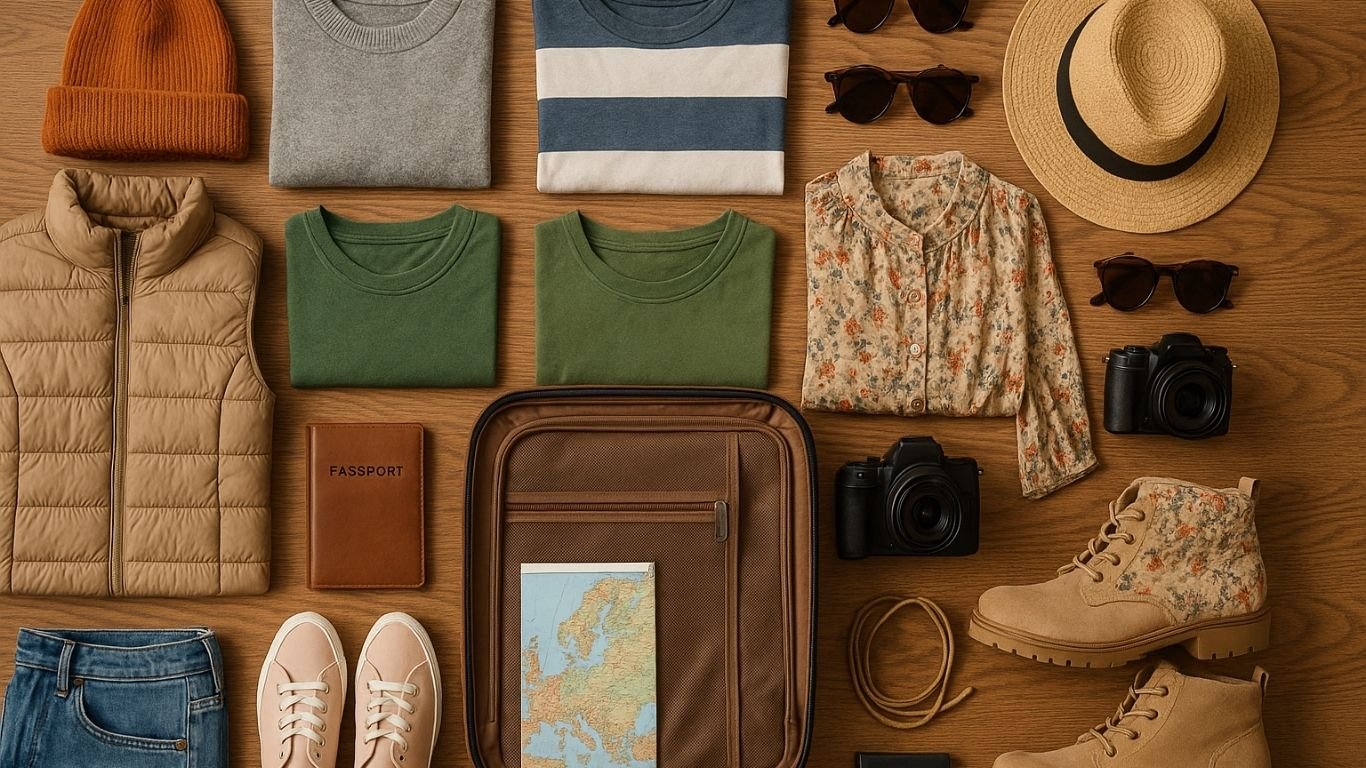Europe—rich in history, diverse in culture, and unpredictable in weather—demands a thoughtful packing strategy. From the sun-drenched beaches of the Mediterranean to the frostbitten alleyways of Prague in winter, what you carry in your suitcase can mean the difference between a seamless journey and a stressful one. Packing isn’t just about fitting things in a bag; it’s about aligning your travel experience with comfort, efficiency, and practicality.
This Europe travel packing list by season is crafted to save both space and sanity. Whether you’re hopping between countries on a whirlwind summer adventure or sipping mulled wine in a charming Alpine village during winter, this guide helps you stay prepared without overpacking. You’ll find expert-backed recommendations, personal insights from seasoned travelers, and space-saving techniques inspired by both industry leaders and local wisdom.
What sets this list apart is its flexibility—tailored not just by seasons but by travel style. Backpackers, luxury travelers, city-break enthusiasts, and countryside roamers alike will find tips that meet their specific needs. We’ve studied what works, what fails, and what locals wear, to give you a refined, actionable list that feels intuitive yet complete.
Let’s unpack smarter travel—one season at a time.
Table of Contents
General Packing Tips for Europe (Year-Round)
Packing for Europe isn’t a one-size-fits-all endeavor. Still, some essentials remain consistent no matter the destination or time of year. Understanding your luggage limits, choosing multipurpose garments, and packing compact tech can streamline your entire journey. Before diving into the seasonal specifics of the Europe travel packing list by season, these foundational tips will help you build a core strategy for space-saving success.
Know Your Luggage Limits
Before you even begin rolling your clothes, check your airline’s baggage policies. European budget carriers like Ryanair or easyJet often have strict cabin baggage rules and steep fees for overweight luggage. Invest in a lightweight, durable carry-on that fits most EU airline restrictions—typically 55 x 40 x 20 cm.
A personal tip: stick to one carry-on and one under-seat item. This not only eliminates wait times at baggage claim but ensures your essentials are always with you. If you’re moving across multiple countries by train or bus, having something manageable makes all the difference when navigating tight luggage compartments and cobblestone streets.
Layering is Key
Europe’s weather is famously unpredictable. You could be basking under the sun in southern France and facing a cold drizzle in Amsterdam just days later. Layering allows you to adapt without packing bulky clothes. Begin with moisture-wicking base layers, add breathable mid-layers (like merino wool or a light fleece), and top it off with a weather-resistant outer shell.
This technique isn’t just about warmth—it’s about flexibility. A capsule wardrobe built around layering options creates space-efficient combinations that work across temperature ranges and dress codes.
Versatile Basics vs. Trendy Items
It’s tempting to bring your entire closet to match every Instagrammable backdrop, but the smarter move is to focus on classic, mix-and-match basics. Neutral tones—black, white, navy, gray—can be combined effortlessly. Choose wrinkle-resistant, breathable fabrics like cotton blends or performance synthetics.
Limit trendy items to one or two statement pieces. Think of a bold scarf or a patterned shirt that can elevate simple outfits. Fashion in Europe leans chic but understated. You’ll blend in better by avoiding over-the-top prints and leaning into polished minimalism.
Travel-Sized Essentials & Smart Toiletries
Toiletries can eat up space quickly—especially when hopping across countries with different climates and water conditions. Choose solid toiletries like shampoo bars, soap sheets, and toothpaste tablets to eliminate liquid restrictions and spills. A hanging toiletry bag keeps everything visible and compact.
If you’re traveling long-term, refillable travel bottles and a microfiber towel are essential. Pack a basic first-aid kit tailored to your needs (painkillers, allergy meds, blister plasters) and always carry travel-sized laundry detergent for handwashing clothes in a pinch.
Must-Have Electronics for Europe Travel
Europe uses Type C and Type F outlets (220V), so a universal travel adapter with USB-C ports is crucial. Add a lightweight power bank for day trips, especially in cities where your phone becomes a navigator, translator, and booking manager.
Noise-canceling earbuds, a compact camera (or just your smartphone), and a digital luggage scale can enhance comfort and control. If you work remotely, a portable keyboard or foldable laptop stand makes train stations and cafés into makeshift offices.
Spring Packing List for Europe (March – May)
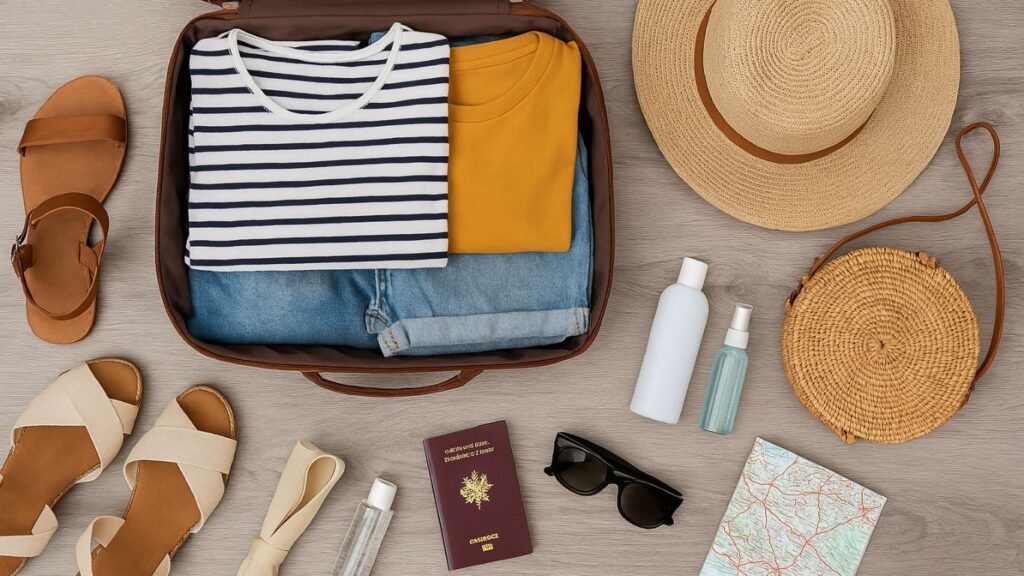
Spring in Europe is a season of transition. Budding trees, café terraces reawakening, and unpredictable showers define the atmosphere. From Parisian strolls under cherry blossoms to hiking in the Scottish Highlands, your Europe travel packing list by season needs to handle variety with grace.
Weather Overview & What to Expect
Spring brings renewed life to Europe, but the weather varies widely by region and month. March can still feel wintry in Northern and Eastern Europe, while Southern countries like Spain and Italy begin to warm. April is notoriously rainy—especially in places like London or Amsterdam—while May often offers the first taste of summer warmth.
Average temperatures range:
- Northern Europe: 5°C to 15°C (41°F to 59°F)
- Central Europe: 8°C to 20°C (46°F to 68°F)
- Southern Europe: 12°C to 24°C (54°F to 75°F)
Expect fluctuating temperatures and the occasional downpour—layers and water resistance are key.
Essential Clothing Items
Pack light, breathable fabrics that can be layered:
- 2–3 long-sleeve shirts (preferably merino or cotton blends)
- 2 t-shirts or blouses for layering or warmer days
- 1–2 lightweight sweaters or cardigans
- 1 weatherproof jacket (preferably with a hood)
- 1–2 pairs of jeans or travel-friendly trousers
- 1 dress or smart outfit for evenings
- Light scarf or shawl for transitional weather
- Compact umbrella or travel poncho
My tip: carry a zip-up fleece or softshell you can stuff into your daypack for chillier mornings and highland wind.
Recommended Footwear
You’ll likely walk a lot, so comfort reigns. Avoid brand-new shoes to prevent blisters.
- Waterproof walking shoes or sneakers (well broken-in)
- One pair of flats or ankle boots for evenings
- Optional: lightweight sandals if visiting Southern Europe in May
Make sure your footwear has solid grip—spring rains can turn old cobblestones dangerously slick.
Accessories & Extras for Spring Travel
- Compact travel umbrella
- Packable raincoat or shell jacket
- Sunglasses with UV protection
- Crossbody anti-theft bag (especially in tourist hotspots)
- Lightweight gloves for cooler early spring evenings
Spring in Europe is also photogenic, so if photography is part of your trip, bring a weatherproof pouch for your camera or phone.
Summer Packing List for Europe (June – August)
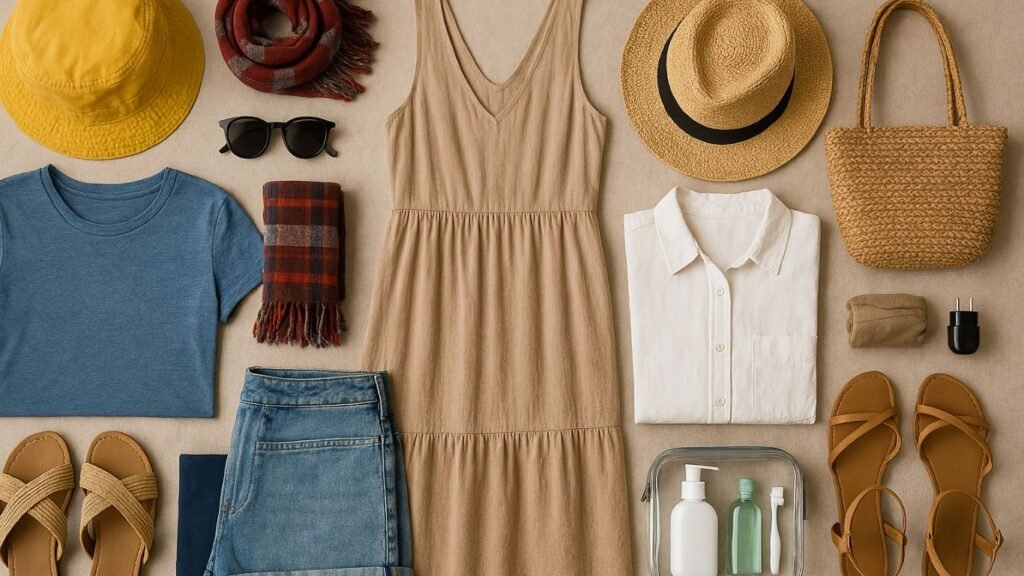
Summer in Europe is vibrant, bustling, and warm—sometimes overwhelmingly so. From sun-drenched islands in the Aegean to music festivals in Scandinavia, packing smart is the difference between feeling free and dragging excess weight across train stations. This section of your Europe travel packing list by season focuses on lightweight efficiency, breathable fabrics, and heat-smart choices that won’t slow you down.
Weather Overview & What to Expect
June to August brings sunshine and crowds. Southern Europe can reach sweltering temperatures, while Northern and Alpine regions offer milder escapes. Humidity varies—coastal cities like Venice or Dubrovnik often feel sticky, while inland areas like Madrid can be dry and scorching.
Typical temperature ranges:
- Northern Europe: 15°C to 25°C (59°F to 77°F)
- Central Europe: 20°C to 30°C (68°F to 86°F)
- Southern Europe: 25°C to 40°C (77°F to 104°F)
Expect long daylight hours, vibrant nightlife, and tourist-packed streets—your wardrobe should keep you cool and comfortable, while blending in with local, often chic, aesthetics.
Essential Clothing Items
Your goal? Breathability and versatility.
- 2–3 lightweight tops (linen, cotton, or moisture-wicking)
- 2–3 pairs of shorts, skirts, or light trousers
- 1–2 summer dresses or jumpsuits for dinners or city nights
- 1 lightweight long-sleeve shirt (sun protection & layering)
- 1 thin cardigan or wrap for cool evenings or air-conditioned museums
- 1 swimsuit (or two if heading to the coast)
- Compact sunhat or wide-brim cap
Europeans tend to dress well—even at the beach. Avoid gym wear in cities unless you’re exercising. Aim for comfortable yet polished.
Recommended Footwear
Comfort is still key, but summer offers more breathable options:
- Comfortable sandals or walking flats (with arch support)
- Lightweight sneakers or travel shoes
- Flip-flops or slides for the beach or hostel showers
Avoid packing more than two pairs unless absolutely necessary. Footwear eats luggage space fast.
Accessories & Extras for Summer Travel
- Sunglasses with strong UV protection
- Reusable water bottle (collapsible ones save space)
- Sunscreen (European brands are expensive—bring your own)
- Lightweight tote or packable day bag
- Foldable fan or cooling towel for intense heat
- Microfiber towel for beach days or quick dry-offs
Pro tip: Pack a silk sleep liner or cotton sleepwear if you’re staying in accommodations without air conditioning—many budget lodgings in Southern Europe don’t offer it.
Fall Packing List for Europe (September – November)
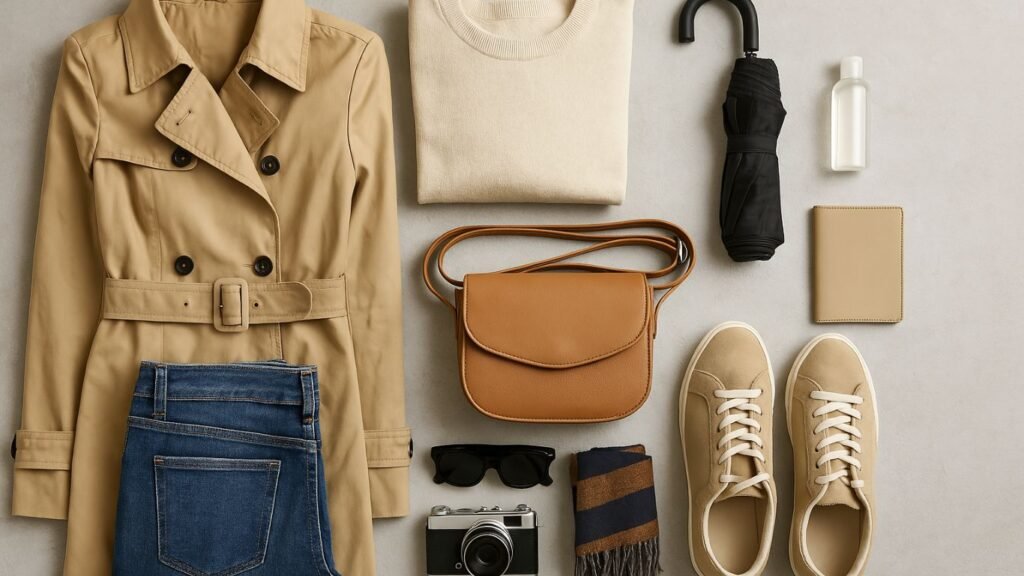
Fall in Europe is an enchanting experience. Golden leaves blanket centuries-old plazas, vineyards burst with harvest energy, and crowds begin to thin. This transitional season, however, can shift dramatically from crisp sunshine to damp fog in just a few days. A well-prepared Europe travel packing list by season ensures you’re ready for city strolls, countryside getaways, or spontaneous café stops under changing skies.
Weather Overview & What to Expect
Fall weather in Europe depends heavily on geography and the time of season. September often holds onto summer’s warmth, particularly in the Mediterranean. October cools steadily, while November invites winter’s edge—especially in Central and Eastern Europe.
Temperature ranges by region:
- Northern Europe: 5°C to 15°C (41°F to 59°F)
- Central Europe: 8°C to 18°C (46°F to 64°F)
- Southern Europe: 15°C to 25°C (59°F to 77°F), warmer in September
Expect intermittent rain, shorter days, and greater temperature variation between mornings and evenings.
Essential Clothing Items
Layers dominate fall travel wardrobes:
- 2–3 long-sleeve shirts or blouses
- 1–2 lightweight sweaters (wool or fleece recommended)
- 1 thermal base layer for colder destinations
- 1 insulated jacket or trench coat
- 1–2 pairs of jeans or heavier trousers
- 1 versatile dress or smart outfit
- 1 scarf or shawl (ideal for both style and warmth)
- 1 packable rain jacket or umbrella
I personally recommend a trench with a removable lining—it bridges both warm days and cool nights without bulk.
Recommended Footwear
Crisp leaves and wet sidewalks call for sturdy footwear:
- Waterproof ankle boots (stylish and practical)
- Comfortable walking shoes or sneakers
- Optional: dressier flats for evenings
Avoid canvas shoes unless they’re water-treated, as dampness can linger in many fall destinations.
Accessories & Extras for Fall Travel
- Compact umbrella (always worth it in Europe)
- Travel-sized moisturizer and lip balm (fall winds dry skin quickly)
- Reusable mug or thermos for coffee on chilly mornings
- Touchscreen-compatible gloves (for late fall)
- Daypack with rain cover
Fall is perfect for countryside excursions—consider packing binoculars or a travel journal to capture scenic moments in quiet villages or golden forests.
Winter Packing List for Europe (December – February)
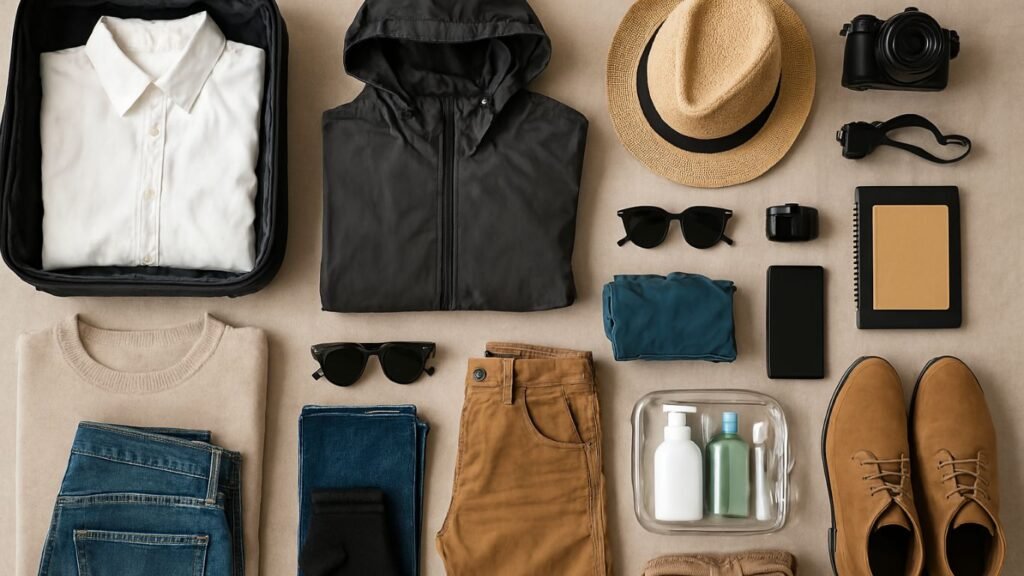
Europe in winter is a magical contrast of frost-covered castles, glowing Christmas markets, and alpine adventures. But behind the postcard-perfect scenes lies a challenge: how do you stay warm without overpacking? This segment of the Europe travel packing list by season focuses on packing smart for the cold—without turning your luggage into a mobile closet.
Weather Overview & What to Expect
Winter in Europe varies drastically. In Scandinavia and Eastern Europe, expect sub-zero temperatures and snow. Central Europe sees chilly winds and gray skies, while Southern Europe—though milder—can still be cold and damp.
Typical winter temperatures:
- Northern Europe: -10°C to 5°C (14°F to 41°F)
- Central Europe: -5°C to 8°C (23°F to 46°F)
- Southern Europe: 5°C to 15°C (41°F to 59°F)
Don’t let Southern Europe fool you—stone buildings with minimal heating can feel colder indoors than out.
Essential Clothing Items
Winter calls for strategic layering and insulation:
- 2–3 thermal base layers (top and bottom)
- 2 wool or fleece sweaters
- 1 insulated, waterproof winter coat (down or synthetic)
- 2 pairs of warm trousers (or thermal leggings under jeans)
- 1–2 long-sleeve shirts for layering
- Warm hat (preferably fleece-lined)
- Gloves (insulated and touchscreen-friendly)
- Wool or thermal socks (pack extras)
Wool-blend garments are your best friend—odor-resistant, insulating, and compact.
Recommended Footwear
Proper winter footwear is non-negotiable:
- Waterproof, insulated boots (snow-ready soles and ankle support)
- Optional: dress shoes for evenings (only if necessary)
- Shoe inserts or thermal insoles for added warmth
Avoid suede or fashion boots unless treated. Wet feet are the fastest path to misery in winter.
Accessories & Extras for Winter Travel
- Neck gaiter or thick scarf (doubles as a face cover in wind)
- Thermal underwear (can serve as sleepwear, too)
- Compact hand warmers (reusable ones are ideal)
- Moisturizer and lip balm (cold, dry air takes a toll)
- Microfiber towel (hotel towels in budget spots may be thin)
Cold-Weather Travel Hacks to Save Space
- Compression bags: Squeeze bulky coats down to half their size
- Wear your bulkiest items: Coat and boots should be worn during transit
- Pack merino wool: Thin but incredibly warm—perfect for layering
- Double-duty gear: Use a fleece jacket as both outerwear and sleepwear
- Use vacuum-seal bags only when necessary: Great for reducing volume, but not ideal for frequent unpacking
Personally, I find that one good coat, two base layers, and one mid-layer suffice for most of Europe—even in the dead of winter—when layered properly.
Packing List Extras Based on Travel Type
Not all European adventures are created equal. A weekend in Vienna differs wildly from a trek through the Scottish Highlands or a luxury getaway on the Amalfi Coast. While the Europe travel packing list by season handles climate, this section dives into additions based on how—and where—you travel. Your experience should feel seamless, not weighed down by the wrong gear.
City Breaks & Urban Adventures
Cities in Europe are as stylish as they are historic. Whether you’re exploring museums in Madrid or wandering markets in Berlin, your packing list should reflect urban functionality and cultural etiquette.
- Comfortable but stylish walking shoes (Europeans dress up, even casually)
- A lightweight, secure day bag or crossbody with anti-theft features
- Foldable tote or shopping bag for local markets
- Compact power bank (days can be long)
- Dressier outfit or accessories for upscale dining or nightlife
- Reusable water bottle—tap water is safe almost everywhere
Tip: Avoid backpacks in crowded metros or museums—they’re often pickpocket targets and can be banned in popular attractions.
Countryside & Nature Escapes
Exploring the Dolomites, cycling through the Loire Valley, or walking the Cotswolds? Comfort and utility come first.
- Lightweight hiking shoes or trail runners
- Packable rain jacket or windbreaker
- Bug spray (especially in summer)
- Daypack with hydration system
- Binoculars or compact camera for nature viewing
- Headlamp or flashlight if you’re venturing off-grid
Bring gear that dries fast and can handle unpredictable weather. Nature in Europe is beautiful—but she doesn’t wait for you to be ready.
Backpacking Across Europe
If you’re city-hopping or Eurail-traveling, you’ll need to pack ultra-efficiently. Every gram matters.
- Convertible clothing (pants that become shorts, dresses that double as beach cover-ups)
- Packing cubes or compression sacks for order
- Flip-flops for hostel showers
- Compact towel and pillowcase (some hostels don’t supply them)
- Padlock for lockers
- Reusable cutlery or collapsible bowl (saves money on food)
A quick-dry travel outfit you can handwash in the sink is a lifesaver for long trips and tight budgets.
Luxury or Business Travel Additions
Business travelers and luxury tourists have unique needs—elevated style, convenience, and time-saving tools.
- Wrinkle-resistant dress shirts, trousers, or formalwear
- Foldable garment bag or packing folder for structured clothing
- Travel steamer or wrinkle spray
- Power adapters with surge protection for electronics
- Digital organizer for cables, chargers, and business cards
- Elegant shoes or heels—compact and comfortable enough for multi-use
Keep your tech gear sleek and organized. First impressions matter at both meetings and five-star lobbies.
Final Tips to Save Space & Sanity
Even the best packing strategy can unravel if you don’t approach it with intentionality. The final leg of this Europe travel packing list by season is all about cutting the clutter, optimizing your load, and maintaining order throughout your trip. Whether you’re on a two-week vacation or a multi-month Euro tour, these tips will help you travel lighter, smarter, and far more peacefully.
Use Packing Cubes & Compression Bags
Packing cubes are your secret weapon for organized chaos. They categorize your gear—tops, bottoms, undergarments, electronics—so you’re not constantly rummaging. Compression cubes, meanwhile, take it a step further by minimizing volume without sacrificing visibility.
Use color-coded sets to distinguish between clean and worn clothes, or to separate by purpose (e.g., hiking gear vs. city wear). They’re especially useful when your itinerary involves multiple destinations.
Pack for One Week, Even on Longer Trips
It’s counterintuitive but effective: pack for a week, no matter how long you’re traveling. Europe has laundromats, hotel laundry services, and even coin-operated machines in train stations.
By packing fewer clothes and rotating your outfits, you free up space for essentials—and souvenirs. Build your wardrobe around a tight color palette so everything matches. One black sweater, two tops, and one pair of pants can generate six or more unique looks.
Do Laundry on the Road
Handwashing is underrated. A small bottle of concentrated detergent and a travel clothesline go a long way. Hotel sinks and hostel bathrooms can handle quick washes, and clothes dry surprisingly fast if you roll them in a towel before hanging.
If you prefer convenience, apps like Laundrapp or ZipJet (popular in major cities like London and Berlin) offer door-to-door laundry services—ideal during longer stays.
Leave Room for Souvenirs
It’s easy to forget the return journey. Leave 20–25% of your bag empty when departing. That way, you’re free to pick up regional wines, artisan scarves, vintage books, or handmade ceramics—without triggering excess baggage fees.
Consider packing a foldable duffel in your suitcase. It takes up almost no space and gives you extra storage when needed.
Conclusion
Packing for Europe is both an art and a science. It’s not about fitting everything—it’s about fitting what matters. Whether you’re navigating snow-laced streets in Vienna, sunbathing on a Greek island, or sipping wine under Tuscan vines, your experience improves tenfold when your gear is tailored to the season and your travel style.
This Europe travel packing list by season is more than a checklist—it’s a curated approach to traveling lighter, smarter, and more intentionally. By mastering layers, choosing the right fabrics, and understanding the nuances of European weather and lifestyle, you unlock a new level of ease on the road. You’re not just prepared—you’re empowered.
So whether you’re planning your first Euro trip or your fifteenth, return to this list as your personal compass. Let it guide your choices and simplify the chaos of travel prep. Because in the end, the best trips aren’t defined by what you packed—but by what you didn’t need to worry about.
FAQ
What is the best luggage for traveling in Europe?
A durable carry-on sized roller or backpack (around 40–45 liters) is ideal. Make sure it complies with EU budget airline size restrictions and is light enough for cobblestone streets and tight stairwells.
How do I dress to blend in with locals in Europe?
Opt for classic, neutral pieces with a tailored fit. Europeans tend to dress neatly and avoid overly casual or athletic wear in public, especially in cities.
Is it better to pack for the weather or the region?
Pack for both. Southern Spain in December is not the same as Norway in March. Always check local forecasts, but align your packing choices with seasonal trends and known regional differences.
Can I buy what I need in Europe instead?
Absolutely—but prices vary. Toiletries and clothing are widely available, but familiar brands may cost more. If you’re particular about products, bring them. Otherwise, enjoy the local shops!
What are the most commonly forgotten items?
Travel adapter, sunscreen, sunglasses, reusable shopping bag, laundry kit, and a lightweight scarf top the list. Don’t forget digital backups of your ID and travel documents too.
